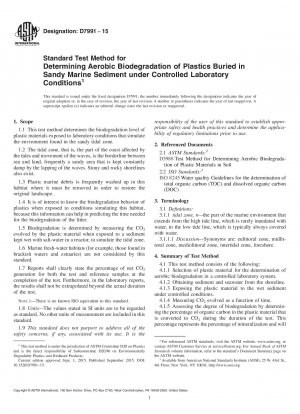ASTM D7991-15
Standard Test Method for Determining Aerobic Biodegradation of Plastics Buried in Sandy Marine Sediment under Controlled Laboratory Conditions
- Standard No.
- ASTM D7991-15
- Release Date
- 2015
- Published By
- American Society for Testing and Materials (ASTM)
- Status
- Replace By
- ASTM D7991-22
- Latest
- ASTM D7991-22
- Scope
5.1 Plastic is sometimes carried by rivers or accidentally discharged by ships into the sea; this plastic can then reach different parts of the marine environment. Tides and waves also frequently deliver plastic marine debris into the sandy tidal zones.
5.2 This test method simulates the environmental conditions found in the tidal zone. Plastic debris that reaches the sandy tidal zone can settle there and become partially or totally buried by sand and kept wet by waves or tides. It is of interest to assess the biodegradation behavior of plastic materials under these conditions to predict the removal time of this waste in the environment.
5.3 This test method is applied to determine the extent of biodegradation of a plastic exposed in the laboratory to a sandy sediment kept wet with seawater. Both sediment and seawater are collected from a sandy beach in the tidal zone. If the natural microbial population present in the sediment is able to biodegrade the plastic, there will be an evolution of CO2 as a consequence of the aerobic microbial respiration. The level of biodegradation at any given time is the ratio between the cumulative amount of the evolved net carbon dioxide and the theoretical amount produced in the case of total conversion of the organic carbon present in the plastic into carbon dioxide.
5.4 This test method does not measure the amount of organic carbon that is converted into biomass, but only the biodegradation that leads to mineralization (that is, the formation of CO2).
1.1 This test method determines the biodegradation level of plastic materials exposed to laboratory conditions that simulate the environment found in the sandy tidal zone.
1.2 The tidal zone, that is, the part of the coast affected by the tides and movement of the waves, is the borderline between sea and land, frequently a sandy area that is kept constantly damp by the lapping of the waves. Stony and rocky shorelines also exist.
1.3 Plastic marine debris is frequently washed up in this habitat where it must be removed in order to restore the original landscape.
1.4 It is of interest to know the biodegradation behavior of plastics when exposed to conditions simulating this habitat, because this information can help in predicting the time needed for the biodegradation of the litter.
1.5 Biodegradation is determined by measuring the CO2 evolved by the plastic material when exposed to a sediment kept wet with salt-water in a reactor, to simulate the tidal zone.
1.6 Marine fresh-water habitats (for example, those found in brackish waters and estuaries) are not considered by this standard.
1.7 Reports shall clearly state the percentage of net CO2 gene......
ASTM D7991-15 Referenced Document
- ASTM D5988 Standard Test Method for Determining Aerobic Biodegradation in Soil of Plastic Materials or Residual Plastic Materials After Composting
- ISO 8245 Water quality - Guidelines for the determination of total organic carbon (TOC) and dissolved organic carbon (DOC)
ASTM D7991-15 history
- 2022 ASTM D7991-22 Standard Test Method for Determining Aerobic Biodegradation of Plastics Buried in Sandy Marine Sediment under Controlled Laboratory Conditions
- 2015 ASTM D7991-15 Standard Test Method for Determining Aerobic Biodegradation of Plastics Buried in Sandy Marine Sediment under Controlled Laboratory Conditions

Copyright ©2024 All Rights Reserved